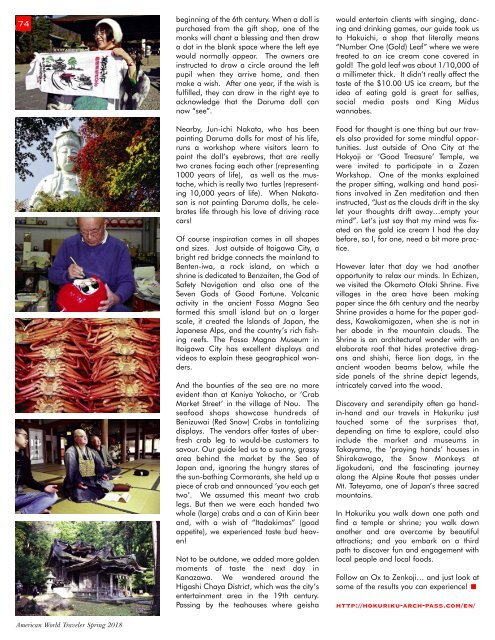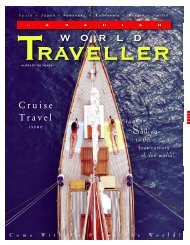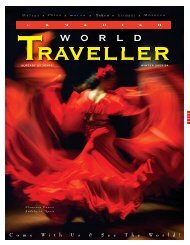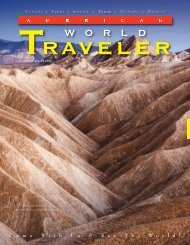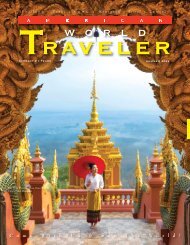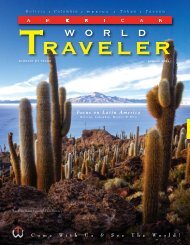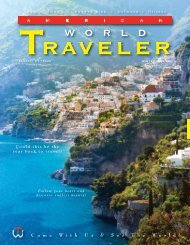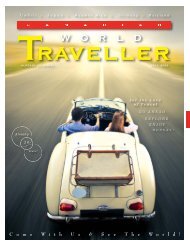American World Traveler Spring 2018 Issue
Now in our 16th year of publishing, American World Traveler explores the culture and history of worldwide destinations, sharing the adventure of discovery with our readers and motivating them to make their travel dreams a reality. Published quarterly, AWT helps sophisticated, independent American travelers choose their next destination by offering a lively blend of intelligent, informative articles and tantalizing photographic images from our World’s best destinations, cruises, accommodations and activities to suit every traveler's taste.
Now in our 16th year of publishing, American World Traveler explores the culture and history of worldwide destinations, sharing the adventure of discovery with our readers and motivating them to make their travel dreams a reality. Published quarterly, AWT helps sophisticated, independent American travelers choose their next destination by offering a lively blend of intelligent, informative articles and tantalizing photographic images from our World’s best destinations, cruises, accommodations and activities to suit every traveler's taste.
Create successful ePaper yourself
Turn your PDF publications into a flip-book with our unique Google optimized e-Paper software.
74<br />
beginning of the 6th century. When a doll is<br />
purchased from the gift shop, one of the<br />
monks will chant a blessing and then draw<br />
a dot in the blank space where the left eye<br />
would normally appear. The owners are<br />
instructed to draw a circle around the left<br />
pupil when they arrive home, and then<br />
make a wish. After one year, if the wish is<br />
fulfilled, they can draw in the right eye to<br />
acknowledge that the Daruma doll can<br />
now “see”.<br />
Nearby, Jun-ichi Nakata, who has been<br />
painting Daruma dolls for most of his life,<br />
runs a workshop where visitors learn to<br />
paint the doll’s eyebrows, that are really<br />
two cranes facing each other (representing<br />
1000 years of life), as well as the mustache,<br />
which is really two turtles (representing<br />
10,000 years of life). When Nakatasan<br />
is not painting Daruma dolls, he celebrates<br />
life through his love of driving race<br />
cars!<br />
Of course inspiration comes in all shapes<br />
and sizes. Just outside of Itoigawa City, a<br />
bright red bridge connects the mainland to<br />
Benten-iwa, a rock island, on which a<br />
shrine is dedicated to Benzaiten, the God of<br />
Safety Navigation and also one of the<br />
Seven Gods of Good Fortune. Volcanic<br />
activity in the ancient Fossa Magna Sea<br />
formed this small island but on a larger<br />
scale, it created the Islands of Japan, the<br />
Japanese Alps, and the country’s rich fishing<br />
reefs. The Fossa Magna Museum in<br />
Itoigawa City has excellent displays and<br />
videos to explain these geographical wonders.<br />
And the bounties of the sea are no more<br />
evident than at Kaniya Yokocho, or ‘Crab<br />
Market Street’ in the village of Nou. The<br />
seafood shops showcase hundreds of<br />
Benizuwai (Red Snow) Crabs in tantalizing<br />
displays. The vendors offer tastes of uberfresh<br />
crab leg to would-be customers to<br />
savour. Our guide led us to a sunny, grassy<br />
area behind the market by the Sea of<br />
Japan and, ignoring the hungry stares of<br />
the sun-bathing Cormorants, she held up a<br />
piece of crab and announced ‘you each get<br />
two’. We assumed this meant two crab<br />
legs. But then we were each handed two<br />
whole (large) crabs and a can of Kirin beer<br />
and, with a wish of “Itadakimas” (good<br />
appetite), we experienced taste bud heaven!<br />
Not to be outdone, we added more golden<br />
moments of taste the next day in<br />
Kanazawa. We wandered around the<br />
Higashi Chaya District, which was the city’s<br />
entertainment area in the 19th century.<br />
Passing by the teahouses where geisha<br />
would entertain clients with singing, dancing<br />
and drinking games, our guide took us<br />
to Hakuichi, a shop that literally means<br />
“Number One (Gold) Leaf” where we were<br />
treated to an ice cream cone covered in<br />
gold! The gold leaf was about 1/10,000 of<br />
a millimeter thick. It didn’t really affect the<br />
taste of the $10.00 US ice cream, but the<br />
idea of eating gold is great for selfies,<br />
social media posts and King Midus<br />
wannabes.<br />
Food for thought is one thing but our travels<br />
also provided for some mindful opportunities.<br />
Just outside of Ono City at the<br />
Hokyoji or ‘Good Treasure’ Temple, we<br />
were invited to participate in a Zazen<br />
Workshop. One of the monks explained<br />
the proper sitting, walking and hand positions<br />
involved in Zen meditation and then<br />
instructed, “Just as the clouds drift in the sky<br />
let your thoughts drift away…empty your<br />
mind”. Let’s just say that my mind was fixated<br />
on the gold ice cream I had the day<br />
before, so I, for one, need a bit more practice.<br />
However later that day we had another<br />
opportunity to relax our minds. In Echizen,<br />
we visited the Okamoto Otaki Shrine. Five<br />
villages in the area have been making<br />
paper since the 6th century and the nearby<br />
Shrine provides a home for the paper goddess,<br />
Kawakamigozen, when she is not in<br />
her abode in the mountain clouds. The<br />
Shrine is an architectural wonder with an<br />
elaborate roof that hides protective dragons<br />
and shishi, fierce lion dogs, in the<br />
ancient wooden beams below, while the<br />
side panels of the shrine depict legends,<br />
intricately carved into the wood.<br />
Discovery and serendipity often go handin-hand<br />
and our travels in Hokuriku just<br />
touched some of the surprises that,<br />
depending on time to explore, could also<br />
include the market and museums in<br />
Takayama, the ‘praying hands’ houses in<br />
Shirakawago, the Snow Monkeys at<br />
Jigokudani, and the fascinating journey<br />
along the Alpine Route that passes under<br />
Mt. Tateyama, one of Japan’s three sacred<br />
mountains.<br />
In Hokuriku you walk down one path and<br />
find a temple or shrine; you walk down<br />
another and are overcome by beautiful<br />
attractions; and you embark on a third<br />
path to discover fun and engagement with<br />
local people and local foods.<br />
Follow an Ox to Zenkoji… and just look at<br />
some of the results you can experience!<br />
http://hokuriku-arch-pass.com/en/<br />
<strong>American</strong> <strong>World</strong> <strong>Traveler</strong> <strong>Spring</strong> <strong>2018</strong>


